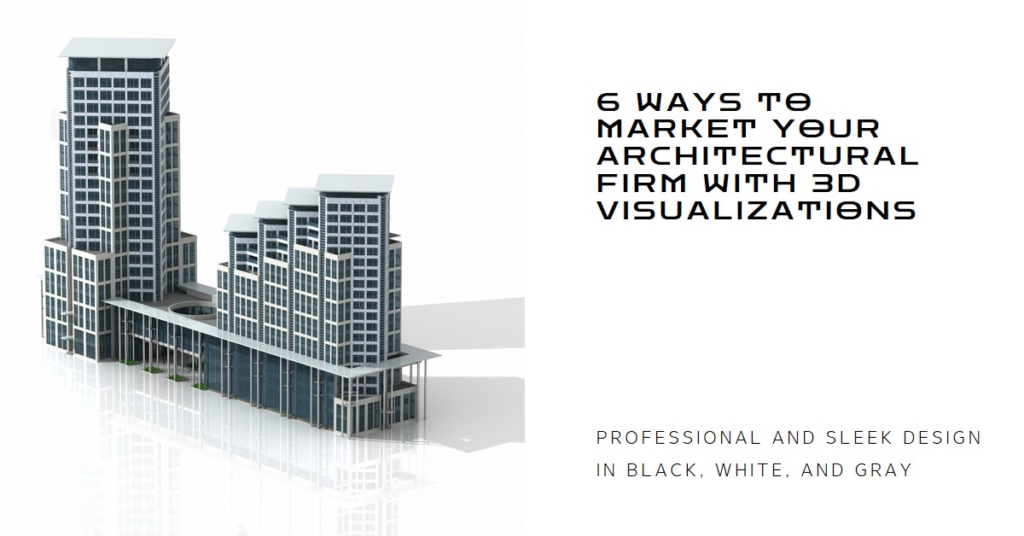
Table of Contents
In the competitive landscape of architectural design, leveraging advanced technologies such as 3D visualizations can significantly enhance an architectural firm’s marketing strategies. These immersive and realistic representations of architectural projects not only showcase design prowess but also captivate clients, investors, and stakeholders, driving business growth and brand recognition. In this insightful blog post, we’ll explore six effective strategies that architectural firms can employ to leverage 3D visualizations for successful marketing campaigns.
1. Creating Compelling Project Presentations: Engaging Stakeholders with 3D Visualization
One of the primary ways architectural firms can use 3D visualizations for marketing purposes is by creating compelling project presentations. By transforming architectural plans and concepts into photorealistic 3D renderings, firms can present their vision with clarity, detail, and visual impact. These presentations are invaluable during client meetings, investor pitches, and project proposals, allowing stakeholders to envision the final outcome accurately.
Utilize 3D animations, walkthroughs, and virtual tours to immerse stakeholders in the project experience, highlighting key design features, spatial layouts, material finishes, and lighting scenarios. Incorporate storytelling elements that convey the project’s narrative, design intent, and unique selling points, fostering emotional connections and buy-in from potential clients and investors.
2. Enhancing Digital Marketing Collaterals: Dynamic Online Presence
In the digital age, an architectural firm’s online presence plays a pivotal role in attracting leads, engaging audiences, and showcasing expertise. Integrate high-quality 3D visualizations into digital marketing collaterals such as websites, social media posts, email campaigns, and digital brochures to create a visually stunning and informative brand narrative.
Feature 3D renderings, concept sketches, and before-and-after comparisons to highlight project transformations, design evolution, and innovative design solutions. Leverage interactive elements such as sliders, galleries, and interactive maps to engage visitors and encourage exploration of project details, design processes, and firm portfolios. Consistent use of 3D visualizations across digital platforms enhances brand recognition, establishes credibility, and differentiates the firm in a competitive market.
3. Leveraging Virtual Reality (VR) Experiences: Immersive Engagement
Embracing virtual reality (VR) technology offers architectural firms a powerful tool for immersive client engagement and marketing experiences. Develop VR walkthroughs, virtual tours, and interactive experiences that allow clients and stakeholders to explore architectural designs in a realistic, 3D environment from anywhere in the world.
VR experiences enable clients to visualize spatial proportions, experience design concepts firsthand, and make informed design decisions with confidence. Showcase design variations, material options, and interior layouts dynamically within VR environments, creating memorable and impactful client interactions that set the firm apart as a technology-forward and client-centric design firm.
4. Collaborating with Media and Publications: Industry Recognition
Architectural firms can leverage 3D visualizations to collaborate with media outlets, industry publications, and design awards platforms, gaining valuable exposure and industry recognition. Provide media partners with high-resolution 3D renderings, project insights, and design narratives to feature in articles, design showcases, and editorial content.
Participate in design competitions, awards programs, and industry exhibitions showcasing projects through 3D visualizations to highlight design innovation, creativity, and technical expertise. Winning or being nominated for design awards elevates the firm’s reputation, attracts media attention, and reinforces credibility among peers and potential clients, contributing to long-term business success.
5. Customizing Client Presentations: Tailored Solutions
Tailoring client presentations with customized 3D visualizations allows architectural firms to address specific client needs, preferences, and project requirements effectively. Create personalized design options, material palettes, and design scenarios based on client feedback, design briefs, and site conditions to demonstrate design flexibility and responsiveness.
Utilize 3D modeling and rendering software to generate real-time design iterations, alternative layouts, and design options during client meetings and design workshops. Incorporate client branding, signage, or interior customization into 3D visualizations for commercial projects, showcasing personalized solutions that resonate with client visions and brand identities.
6. Engaging Social Media Campaigns: Visual Storytelling
Social media platforms offer architectural firms a dynamic space to engage audiences, showcase projects, and build brand awareness through visual storytelling. Craft engaging social media campaigns centered around 3D visualizations, project progress updates, design insights, and behind-the-scenes content to captivate followers and attract new audiences.
Utilize platforms like Instagram, Pinterest, and LinkedIn to share stunning 3D renderings, project animations, design process videos, and client testimonials that highlight the firm’s expertise and design excellence. Encourage user-generated content, interactions, and discussions around design trends, sustainability, and innovative design solutions, fostering a vibrant online community around the firm’s brand.
7. Hosting Virtual Design Events: Thought Leadership and Networking
Incorporate virtual design events, webinars, and panel discussions into the firm’s marketing strategy to position the firm as a thought leader in the architectural industry. Use 3D visualizations to illustrate design concepts, case studies, and industry insights during virtual presentations, engaging participants and showcasing the firm’s expertise.
Collaborate with industry partners, guest speakers, and influencers to host impactful virtual events that attract a diverse audience of clients, professionals, students, and design enthusiasts. Foster networking opportunities, knowledge sharing, and collaborative discussions around emerging trends, sustainability practices, and future of design, reinforcing the firm’s reputation and network within the industry.
8. Showcasing Sustainable Design Practices: Environmental Responsibility
Highlighting sustainable design practices through 3D visualizations allows architectural firms to showcase their commitment to environmental responsibility and green building principles. Create visual narratives that emphasize sustainable features such as passive design strategies, renewable energy systems, water conservation measures, and green building certifications.
Illustrate energy-efficient lighting solutions, natural ventilation strategies, green roof installations, and recycled materials integration within architectural designs through 3D renderings and animations. Partner with sustainability experts, environmental organizations, and green building councils to amplify messages of eco-conscious design, resilience, and environmental stewardship through marketing campaigns and thought leadership initiatives.
9. Incorporating Client Testimonials and Success Stories: Trust Building
Incorporate client testimonials, success stories, and project case studies featuring 3D visualizations into marketing materials to build trust, credibility, and client confidence in the firm’s capabilities. Showcase real-life projects, client feedback, and project outcomes that highlight design excellence, client satisfaction, and successful project deliveries.
Include before-and-after comparisons, project timelines, and client testimonials that emphasize the firm’s collaborative approach, communication transparency, and design innovation. Highlighting past successes and positive client experiences through visual storytelling strengthens the firm’s brand reputation, attracts prospective clients, and fosters long-term client relationships based on trust and mutual respect.
10. Monitoring Analytics and Performance Metrics: Data-Driven Strategies


Implement data-driven marketing strategies by monitoring analytics, performance metrics, and user engagement data related to 3D visualizations across marketing channels. Use analytics tools, website metrics, and social media insights to track audience reach, engagement rates, conversion metrics, and user interactions with 3D visual content.
Analyze data trends, audience preferences, and content performance to optimize marketing campaigns, content strategies, and audience targeting strategies effectively. Adapt marketing messages, content formats, and distribution channels based on data insights to maximize ROI, brand visibility, and lead generation efforts driven by 3D visualizations and immersive content experiences.


